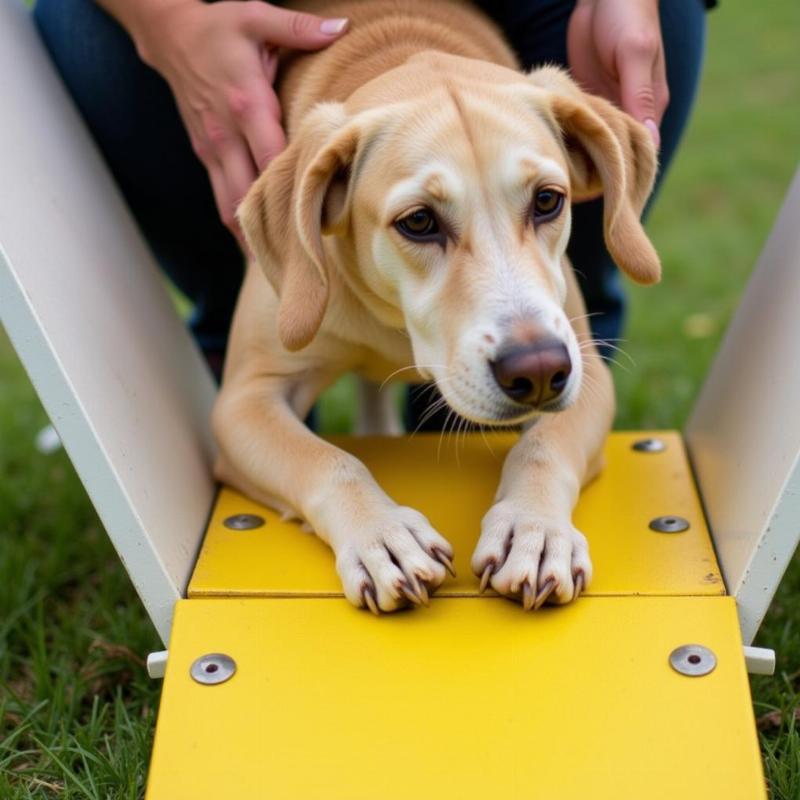The agility A-frame is a challenging and rewarding obstacle in dog agility courses. It tests your dog’s balance, coordination, and confidence as they navigate the steep incline and decline. Choosing the right A-frame and implementing effective training techniques is crucial for your dog’s success and safety. This comprehensive guide will cover everything you need to know about agility A-frames for dogs, from selecting the perfect frame to mastering the climb.
Choosing the Right Agility A-Frame
Selecting the appropriate A-frame is paramount for your dog’s safety and progress. Consider your dog’s size, breed, and experience level when making your decision. For smaller dogs or beginners, a lower A-frame with a wider base provides more stability. Larger, more experienced dogs can handle taller, narrower frames. Look for A-frames constructed from durable, weather-resistant materials that provide excellent traction.
Material and Construction
A-frames are typically made from wood, plastic, or aluminum. Wood offers a natural look and good grip but requires regular maintenance. Plastic is lightweight and easy to clean, while aluminum is durable and weather-resistant. Ensure the contact surface provides sufficient traction to prevent slips and falls.
Portability and Storage
If you plan to transport your A-frame frequently, consider its portability and storage requirements. Folding A-frames are convenient for travel and storage.
Training Your Dog on the A-Frame
Introducing the A-frame gradually and positively is essential for building your dog’s confidence. Start with a low incline and use positive reinforcement, such as treats and praise, to encourage your dog to climb. Gradually increase the incline as your dog becomes more comfortable. Consistency and patience are key to successful A-frame training.
 Dog Agility A-Frame Contact Training
Dog Agility A-Frame Contact Training
Contact Training
Teaching your dog to touch the contact zones at the top and bottom of the A-frame is crucial for safety and scoring in competitions. Use verbal cues and target training to encourage contact behavior.
Building Confidence
Positive reinforcement and gradual progression are vital for building your dog’s confidence on the A-frame. Celebrate small successes and never force your dog to climb if they are hesitant.
Safety Considerations
Always supervise your dog during A-frame training and ensure the surrounding area is free of hazards. Start with low inclines and gradually increase the height as your dog progresses. Use a harness for added safety and control, especially during the early stages of training.
Conclusion
The agility A-frame is a challenging but rewarding obstacle for both dog and handler. By choosing the right A-frame and implementing effective training techniques, you can help your dog master this obstacle with confidence and enjoy the thrill of dog agility. Remember to prioritize safety, patience, and positive reinforcement throughout the training process.
FAQ
- What age can a dog start A-frame training? While puppies can be introduced to low inclines, full A-frame training should begin after their growth plates have closed, typically around 12-18 months of age.
- How can I prevent my dog from slipping on the A-frame? Ensure the A-frame surface provides adequate traction. You can also add non-slip mats or tape to enhance grip.
- What should I do if my dog is afraid of the A-frame? Start with a very low incline and use positive reinforcement to encourage your dog to approach and climb. Gradually increase the incline as their confidence grows.
- Are there different types of A-frames for different dog breeds? While not breed-specific, the size of the A-frame should be appropriate for your dog’s size and experience level.
- How often should I train my dog on the A-frame? Short, frequent training sessions are more effective than long, infrequent ones. Aim for 2-3 sessions per week.
- Can I build my own agility A-frame? Yes, but ensure it is sturdy, safe, and meets the required specifications for competitions if you plan to compete.
- What are the benefits of A-frame training for dogs? A-frame training improves a dog’s balance, coordination, confidence, and strengthens their core muscles.
Beautdogs.us is your premier online destination for comprehensive and engaging dog care information in the USA. We offer expert advice on dog breeds, training, nutrition, and much more. Whether you’re a first-time dog owner or a seasoned expert, Beautdogs.us provides trustworthy resources to enhance your dog’s well-being and strengthen your bond. Contact us today at [email protected] or call us at +1 501-555-7529 for personalized guidance and discover a world of valuable information at Beautdogs.us!